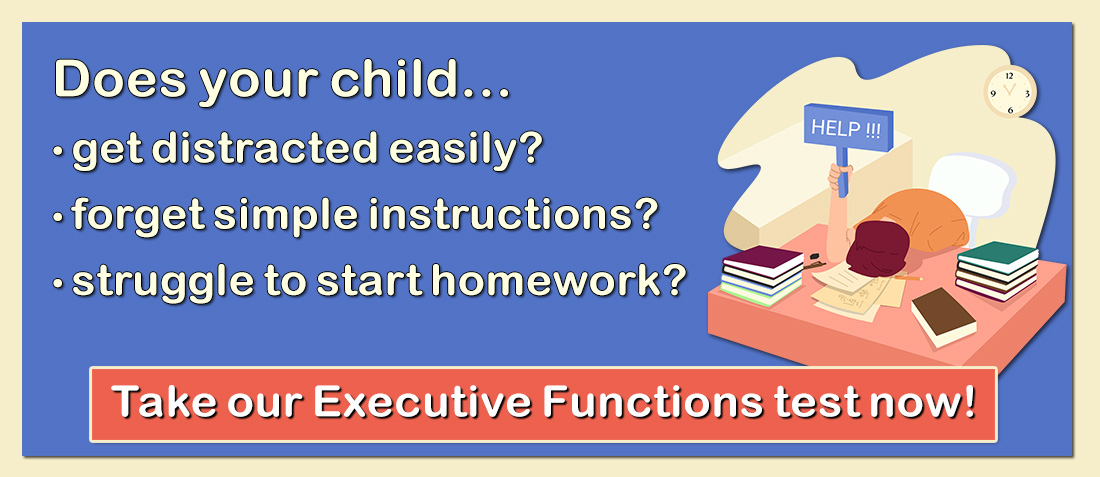
Photo Credit: Randy Pederson
Sustained attention involves the ability to maintain one’s focus and attention in the presence of distractions and other activities. It involves the ability to return to an activity when interrupted and to persist in attending to a tedious or boring task. It may also involve the process of attending to multiple sources of information and being able to selectively choose what is most important to attend to. Sustained attention is developmental, as older children may need to be able to attend for longer periods to complete more complex tasks. Displays of sustained attention are typically increased for children when they find a task to be particularly interesting or varied. Improve sustained attention by following many of our strategies.
Home and School Situations Requiring Sustained Attention
- Sitting down to complete homework in a timely fashion
- Maintaining focus in conversations and discussions with others
- Continuing to work on tasks that may be boring or dull, such as a chore
- Sitting still through a short ceremony such as a wedding, graduation, or confirmation
- Completing one play activity or homework assignment before starting another
- Ignoring surrounding noise and activities to concentrate on the task at hand
- Sitting though an entire lunch or dinner
- Watching a complete television show or movie
- Sitting or listening to an entire story or reading
Hints and Strategies to Improve Sustained Attention
1. Allow interesting and stimulating tasks to follow boring and mundane tasks. It may be difficult for your child to sustain his/her attention to tasks that (s)he finds to be uninteresting. Your child may be more inclined to pay attention to and complete such tasks when (s)he can look forward to doing something (s)he enjoys once the task is completed. This can be going outside to play after s homework is finished, or having dessert after (s)he has eaten dinner. Model this strategy to help your child take on greater responsibility and reduce conflicts. For example, discuss how you sometimes complete an uninteresting chore prior to an enjoyable activity (such as doing the dishes prior to relaxing).
2. Be clear and concise when giving directions. Do not overload your child with too many words or directions and ask them to paraphrase what they have heard when new directions are provided. This can help your child to process and reflect on new or important information. Rather than lecture about the need to wear a hat and put on sunscreen during the summer to prevent damage from the sun, provide key words, such as “hat” and “sunscreen.”
3. Involve your child in activities requiring social interaction and assisting others. Volunteer activities are not only self-rewarding, they also engage your child’s attention. Hands-on volunteer activities such as taking care of animals at an animal shelter, Scout groups, or environmental clean-ups can be very positive experiences for starting, sustaining, and maintaining attention.
4. Encourage your child to talk about the components of activities. Have your child discuss the activities that keep him engaged and use these as guides for the selection of later activities and part-time jobs.
5. Encourage your child to participate in activities that require their full attention. For example, in baseball, have them play catcher, pitcher, or first-base. These positions will require your child to sustain their attention more than in the outfield. In music, (s)he could be encouraged to play instruments that are a regular part of the band or orchestra, rather than something such as cymbals, which are rarely used. Helping your child to recognize the differences in attention and involving him/her in activities requiring higher levels of attention could improve your child’s choices as (s)he matures.
6. Use competition to sustain attention. Challenge your child to see who fully completes a task first. For instance, have a race to see if (s)he can complete a portion of his homework prior to your completion of a task, such as putting the food away after grocery shopping. Competition often serves to help children sustain their focus. Children with a competitive nature could be encouraged to come up with their own strategies for competing against themselves or others. Attempt to engage siblings, friends, or other caregivers in these friendly competitions.
7. Actively search for technologies in which your child can sustain his/her attention for extended periods of time. As you determine which technologies help your child sustain attention, see if you can find methods to use these to sustain his/her academic development and enhance your child’s sense learning. It is very important for your child to be able to demonstrate that their knowledge of digital technologies may become an appropriate strategy for teaching.
8. Try out a range of technologies that can sustain attention to learning. These can include technologies such as the following: listening to audio books, watching a DVD about a book being read in school, using a calculator for doing math homework, or getting an i-Phone/iPod Touch with an application that teaches a foreign language. Help your child to articulate what about the technology helps him/her to pay attention for extended periods of time; encourage your child to think about ways that (s)he can use this knowledge to help learn other materials.
9. Use physical activity to enhance the brain chemistry that supports sustained attention. Emerging neuroscience research indicates that children can pay attention better and for longer periods of time after vigorous physical exercise. You may wish to encourage your child to engage in physical exercise prior to doing homework or studying for a test. Help your child chart, or monitor the impact of vigorous exercise on his academic attention and performance.
10. Encourage your child to identify activities and content that sustains his/her attention. While many children with attention difficulties have a very limited number of things that keep them focused, such as video games, computer, television, Legos, or high-risk activities, there may be associated areas that will peak their interest on a regular basis. Work with your child to expand his/her interests so that perhaps (s)he begins reading about video games or skateboarding, writing his/her own stories about fantasy characters, or using art materials in an innovative and unusual fashion.
Games and Activities That Can Practice Sustained Attention
“Guitar Hero” and “Dance Dance Revolution” – Games, such as “Guitar Hero” and DDR, in which regular repetition of tasks is required for successful game play, will help your child to improve sustained attention skills.
“Memory” and other card games – Card games that require the player to observe and remember what has been discarded or held in someone’s hand can be very good practice for sustained attention and working memory.
“Simon Says” and “Guess Who?” – Activities that require repetition or description are helpful in practicing sustained attention.
Games such as “Find the Difference” in which two similar but slightly different pictures are provided – These games can be helpful in allowing your child to practice using a systematic strategy for visual searches and maintaining focus or attention during the challenge.
Puzzles – Increasing the difficulty of a puzzle (from 100 to 200 to 1000 pieces) can allow your child to practice extending his sustained attention.
“Where’s Waldo?”, “I Spy,” and Other Search and Find Books – These books require sustained and organized attention and can be used by children and parents cooperatively.
Websites and Articles on Sustained Attention
LearningWorks For Kids: The premier resource for executive function information, offering a detailed explanation of sustained attention, tips for parents, and activities to improve this skill.
Great Schools: This site offers specific tips on how to help a discouraged child.
Kids in Power: This site provides five simple ways for parents to help children with their concentration skills; take a look!
Books on Sustained Attention
A Teens Guide to Getting Stuff Done by Jennifer Shannon, LMFT. (Ch. 11)“In this fun and illustrated guide, author Jennifer Shannon blends acceptance and commitment therapy (ACT) and cognitive behavioral strategies to help you recognize your procrastination habits, discover the strengths of your unique procrastination type, and find the motivation you need to meet important deadlines and reach your highest goals.”- Amazon
Brain Hacks: Work Smarter, Stay Focused, and Achieve Your Goals by Lara Honos-Webb, PhD. (Ch. 2)“Filled with actionable strategies proven to improve focus, increase productivity, and promote well-being, Brain Hacks will help you transform the way you work, live, and feel by tapping into the power of your executive functioning skills.” – Amazon
Executive Functioning Skills Printables Workbook: For Students Learning Life Skills S.B. Linton (Pg.51-56)“For teens and youth with special needs. These are Executive Functioning Skills Printables Worksheets for Students with Autism, Similar Special Needs, ADHD, LD and Executive Functioning Needs.”- Amazon
Executive Functioning Workbook for Kids: 40 Fun Activities to Build Memory, Flexible Thinking, and Self-Control Skills at Home, in School, and Beyond by Sharon Grand, PhD, BCN. (Ch. 3)“Help kids grow their executive functioning skills with activities for ages 6 to 9!”- Amazon
Focus: The Hidden Driver of Excellence by Daniel Coleman (Part 1,6)“In Focus, Psychologist and journalist Daniel Goleman, author of the #1 international best-seller Emotional Intelligence, offers a groundbreaking look at today’s scarcest resource and the secret to high performance and fulfillment: attention.”- Amazon
Playing Smarter in a Digital World: A Guide to Choosing and Using Popular Video Games and Apps to Improve Executive Functioning in Children and Teens by Randy Kulman, Ph.D. (Ch. 12)“A book to help parents to make their children’s digital playtime educational”- Amazon
Scattered to Focused: Smart Strategies to Improve Your Child’s Executive Functioning Skills by Zac Grisham (Ch. 8)“Set your child up for success with simple strategies to develop executive function in kids 4 to 12”- Amazon
Smart but Scattered: The Revolutionary “Executive Skills” Approach to Helping Kids Reach Their Potential by Peg Dawson, EdD, and Richard Guare, PhD (Ch. 14)“Small changes can add up to big improvements–this empowering book shows how.”- Amazon
The Conscious Parent’s Guide To Executive Functioning Disorder by Rebecca Branstetter, PhD (Ch. 6)“With the strategies and advice in this guide, you and your child will build sustainable bonds, develop positive behaviors, and improve executive functioning skills for life.” – Amazon
The Everything Parent’s Guide to Children with Executive Functioning Disorder: Strategies to help your child achieve the time-management skills, … needed to succeed in school and life by Rebecca Bransetter, PhD. (Ch. 7)“The vital skills children need to achieve their full potential!” – Amazon
Train Your Brain for Success: A Teenager’s Guide to Executive Functions by Randy Kulman, Ph.D. (Ch. 5)“ Beginning with a test to determine executive-functioning strengths and weaknesses, the book then explores in detail eight distinct sets of skills, including planning, organization, focus, time management, self-control, , memory, and self-awareness.”- Amazon
Receive online class information and helpful tips from Dr. Randy Kulman's LearningWorks for Kids |



